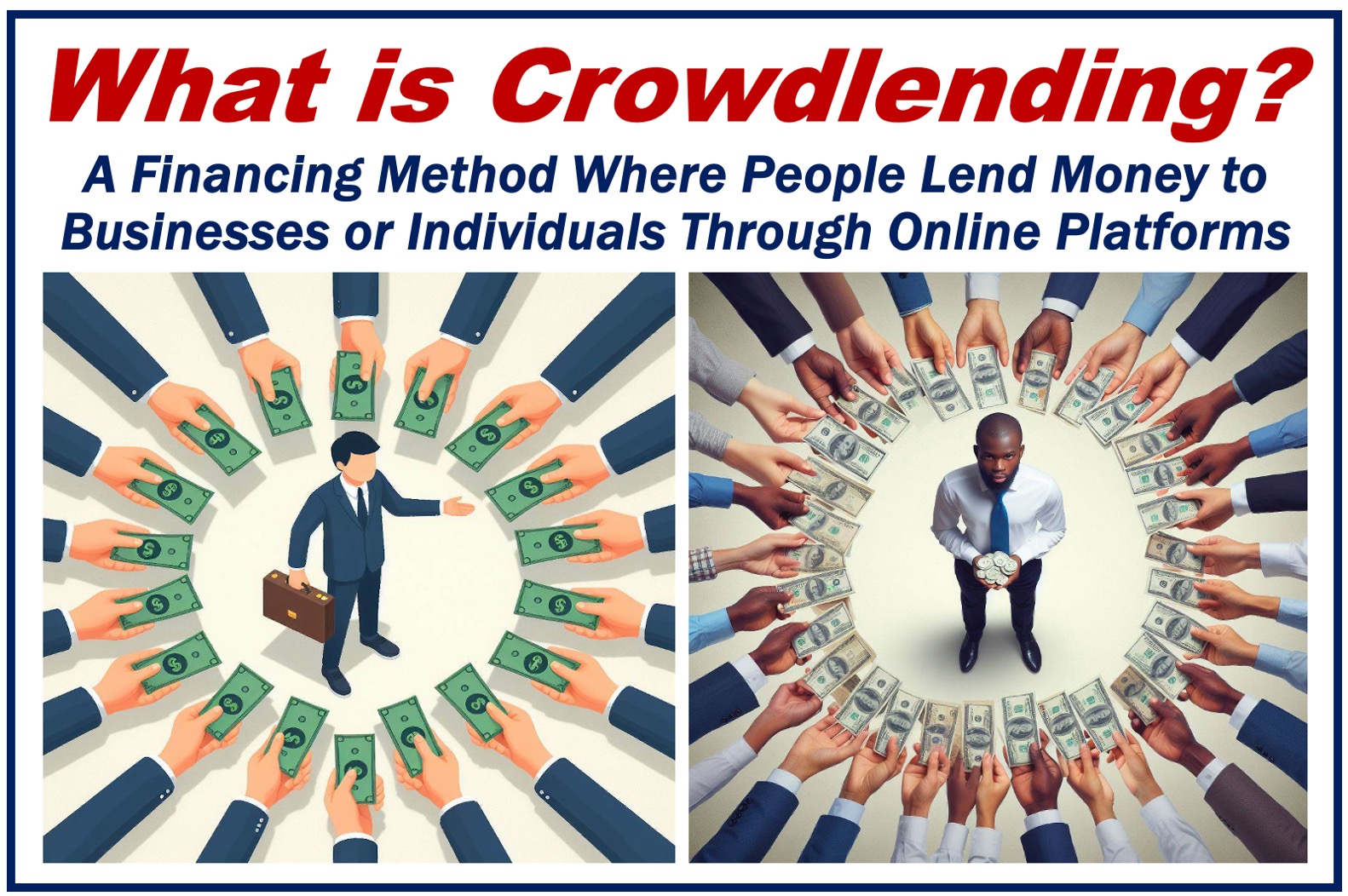Crowdlending or Peer-to-Peer Lending (P2P Lending) is a way of financing in which people lend money directly to individuals or businesses through online platforms, bypassing traditional financial institutions such as banks.
We can spell the term as either one or two words, with or without a hyphen, that is, crowdlending, crowd lending, or crowd-lending. It is important to choose one spelling option and stick to it throughout a text or article; do not switch in the middle.
Wikipedia.com has the following definition of crowdlending (it uses the term “peer-to-peer lending”):
“The practice of lending money to individuals or businesses through online services that match lenders with borrowers. Peer-to-peer lending companies often offer their services online, and attempt to operate with lower overhead and provide their services more cheaply than traditional financial institutions.”
Crowdlending becoming increasingly popular
As a form of direct financing, crowdlending is gaining popularity for its ease of access and potential benefits for both the lender and borrower.
Crowdlending platforms connect people who need funding with those who have money to invest.
This system enables borrowers to receive funds that they might not qualify for from traditional banks, often at lower interest rates. For investors (lenders), it offers an opportunity to earn interest at higher rates than traditional investments such as savings accounts.
Borrowers and lenders enjoy more favorable interest rates because crowdlending platforms operate online and typically have lower overhead costs than traditional banks, which must maintain physical branches and a larger staff.
What is the procedure?
If you want to borrow money, you apply for a loan on a crowdlending platform. You must detail your financial needs and the purpose of the loan.
Lenders review your request and decide whether to lend you money. Lenders choose whom to lend to based on the risk and return that suits them.
Loans may be funded by one or several investors, spreading the risk.

Crowdfunding – straightforward investing and borrowing
The appeal in this type of lending lies in its simplicity and the mutual benefit it provides. Borrowers can access funds more quickly and with less bureaucracy (paperwork) than traditional bank loans.
For investors, crowdlending offers the chance to diversify their portfolio and engage directly with their investments. Some investors support borrowers in their projects with mentorship, business networking opportunities, strategic advice, market access, and operational guidance.
Not risk-free
Like any investment, crowdlending comes with risks. Borrowers may default on their loans. If you plan to be a lender, perhaps you should consider diversifying your lending to spread the risk.
Crowdlending vs. crowdfunding
Crowdlending is a subset of crowdfunding
-
Crowdfunding
Crowdfunding includes loans, donations, and equity investments. It democratizes access to funding, allowing anyone with an internet connection to support or kickstart a project.
-
Crowdlending
Crowdlending specifically refers to the practice of raising funds through loans.
Words with “crowd” as a prefix
The term “crowdlending” has the word “crowd” as a prefix. There are many such words in the English language; most of them emerging after the advent of the Internet. Let’s have a look at some of these terms, their meanings, and how we can use them in a sentence:
-
Crowdfunding
The practice of funding a project or venture by raising small amounts of money from a large number of people, typically via the Internet.
Example: “Their innovative tech startup was brought to life through crowdfunding, where thousands of online supporters donated.”
-
Crowdsourcing
Obtaining information or input into a task or project by enlisting the services of a large number of people, either paid or unpaid, typically via the Internet.
Example: “The company used crowdsourcing to gather ideas for their new product design, allowing them to tap into the creativity of the public.”
-
Crowdworking
Performing tasks or jobs by leveraging a flexible, on-demand workforce where individuals contribute to microtasks or projects online.
Example: “Crowdworking platforms enable people to earn money by completing small tasks that contribute to a larger project.”
-
Crowdcreation
The collective creativity of a large group of people, usually from an online community, to create content, products, or ideas.
Example: “The animation film was a result of crowdcreation, with contributions from artists all over the world.”
-
Crowdspeaking
A method where individuals support a cause or message by agreeing to share it across their social media accounts simultaneously.
Example: “The environmental campaign gained massive attention through crowdspeaking, as thousands tweeted about it at the same time.”
-
Crowdsearching
The process of enlisting the help of a large group of people to help find a missing person or object. Example: “After the child went missing, the community engaged in crowdsearching, using social media to spread the word and organize search efforts.”
-
Crowdvoting
A system where a large group of people vote on an issue or make a decision democratically, often facilitated by online platforms.
Example: “The design for the new community center was selected by crowdvoting, with residents casting their votes online.”
-
Crowdintelligence
The collective intelligence and knowledge that emerges from the collaboration and competition of many individuals, often used in problem-solving and innovation.
Example: “They tapped into crowdintelligence to solve complex data problems that were too challenging for any single researcher.”
Conclusion
Crowdlending is a modern, digital approach to lending and borrowing. It offers benefits to both parties. As this any financial decision, you should do thorough research and consider the risks before committing yourself.
Video – What is Crowdfunding?
This video presentation, from our YouTube partner channel – Marketing Business Network, explains what ‘Crowdfunding’ is using simple and easy-to-understand language and examples.
